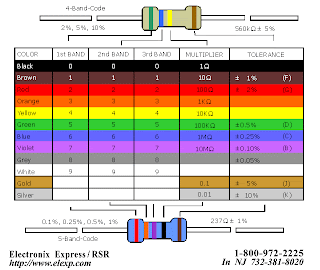What are Resistors?
Resistors are electronic components that are used in circuits to restrict the flow of electric current so that other components, for example; Diodes where they don’t have any resistance in them, so if no resistor was connected in series with the diode it would blow from too much current flow. The higher the value of resistance (measured in ohms law) the lower the current will be.
You can identify what value a resistor is by taking note of the coloured bands and turning them into calculations to figure out what value the resistor is. Each colour represents a number.
http://www.elexp.com/tips/clr_code.gif
To calculate the resistor shown above you compare the colour bands to the digits shown in the colour code chart. The first colour on the band gives you the first digit. The second band gives you the second digit and the third band gives you the digit of how many zeros you have to add to the calculation. So for example red is the first band and it represents 2, purple is the second digit to add which is 7, therefore the value so far is 27, and the third colour represents how many zero’s to add to the calculation which is yellow and yellow represents 4 so the value of the resistor will be 270000 ohms or 270k ohms. The fourth colour band represents the tolerance of the resistor. Gold makes one decimal place smaller 0.1 and silver makes two decimal places smaller 0.01 to the calculation.
below is a video of how to calculate resistor bands. I got this video off youtube.
http://www.youtube.com/watch?v=ab-enxLlYlU
Resistors in circuits:
You can connect the resistor in any way round. You can solder them and the heat won’t damage them. Resistance is measured in ohms and the symbol for ohms is an omega sign.
Potentiometer type:
Below is a video of how a Potentiometer type resistor works. It is a video i got off Youtube.
http://www.youtube.com/watch?v=MXFvWLrpVSk
below is a video of how to calculate resistor bands. I got this video off youtube.
http://www.youtube.com/watch?v=ab-enxLlYlU
Resistors in circuits:
You can connect the resistor in any way round. You can solder them and the heat won’t damage them. Resistance is measured in ohms and the symbol for ohms is an omega sign.
When resistors are connected in a series circuit the total resistance adds up to the individual resistances added together. For example Rt total resistance equals R1 + R2 + R3…
http://sub.allaboutcircuits.com/images/00087.png
The circuit above is of a series resistive circuit. To calculate the total resistance the formula Rt = R1 + R2 + R3 is used. Therefore Rt = 3000 + 10000 + 5000.
The combined resistance in a series circuit would always have a higher value than any of the individual resistors.
Resistors are identified in a circuit by the following pictures
Coils are not really used as resistors or to identify them in a circuit, but they do have resistance in them and they do get put in to calculations when working out the resistance in some circuits.
http://upload.wikimedia.org/wikipedia/commons/thumb/archive/f/f7/20070207122618!Resistor_symbol_GOST.svg/120px-Resistor_symbol_GOST.svg.png
This type of resistor symbol is commonly used.
Resistors in parallel circuits are calculated different. The combined resistance in a parallel circuit will always have a lower value of resistance than any of the individual resistors. In this circuit resistors get there own voltage supply unlike in a series circuit each resistor has to divide the voltage. And if only 1 resistor is damaged and doesn’t conduct electrons in a parallel circuit then that is the only resistor that wouldn’t be working. But in a series circuit if only 1 resistor or component fails then the whole circuit would be open.
http://www.tpub.com/neets/book1/chapter1/1-29.gif
Above is a picture of different types of resistors and their symbols.
Fixed carbon:
Depositing a carbon film onto a small ceramic cylinder makes this resistor. These types of resistors are most popular.
Potentiometer type:
Below is a video of how a Potentiometer type resistor works. It is a video i got off Youtube.
http://www.youtube.com/watch?v=MXFvWLrpVSk
Hybrid Vehicles
A Hybrid vehicle is a vehicle that has an electric motor and a internal combustion engine connected in series or parallel to operate the vehicle.
How it works?
A Hybrid vehicle works like a normal vehicle when you first put the key in and start it up. The combustion engine creates energy for the vehicle to move until the engine warms up. When the vehicle stops at a traffic light when the engine is warmed up the electric motor turns on while the engine turns off which then means the engine uses less fuel saving the driver money and there would be no exhaust gases being created and coming out the tail pipe polluting the air. You can pull away and drive around at normal speeds using only electric power and if you want to pick up speeds the combustion engine will automatically turn on silently and smoothly and at that point the electric and engine will be running the vehicle. The electric motor will then turn off leaving only the combustion engine running for high speeds which also charges the electric motors battery.
Below is a video of how this type of hybrid vehicle works:
http://www.youtube.com/watch?v=2HrQeGzIZoI&feature=related
Below is a video of how this type of hybrid vehicle works:
http://www.youtube.com/watch?v=2HrQeGzIZoI&feature=related



















